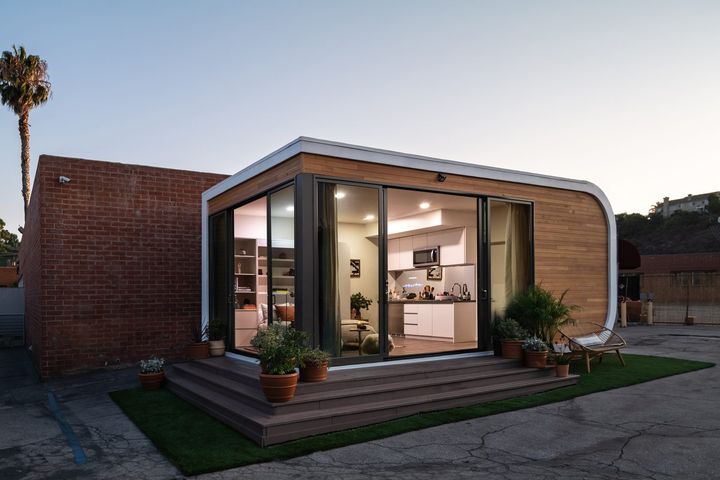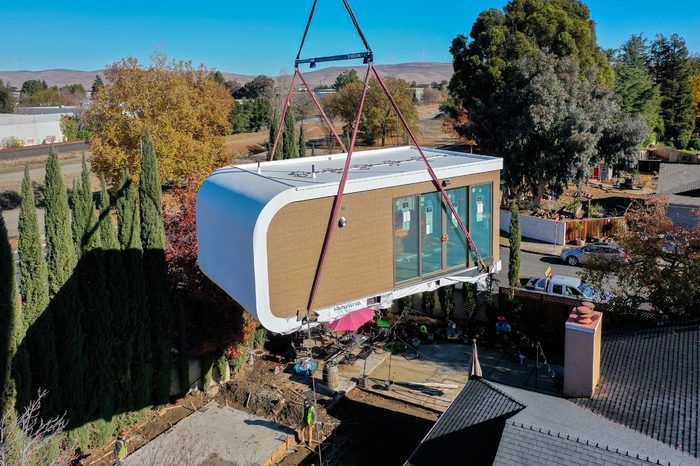
I have some thoughts about a new construction 3D printing startup, Mighty Buildings.
California-based Mighty Buildings is a startup that’s been around for only a few years, and they do things a bit differently than most of the other construction 3D printing companies. We introduced Mighty Buildings to readers six months ago.
For starters, they follow the standard venture route as is done by many California startups. They have “top tier” investors, including Y Combinator, Kholsa, and others. This provides them access not only to funds but also to expertise and networking connections.
Technically, Mighty Buildings operates in a different manner than other construction 3D printer operations. In most cases the construction 3D printer is erected at the build site and printing begins. This is because the structures being 3D printed are usually huge and not amenable to being moved.
Instead of on-site 3D printing, Mighty Buildings operates their equipment from a central factory, where they produce building elements. These are then used to assemble an entire home, still in the factory. Finally, the completed 3D printed home is shipped to the building site by truck and placed in its final position by crane.

This process itself is another difference: while most construction 3D printers merely extrude the concrete portions of a structure and others complete the remaining work on the building, Mighty Buildings does all the work themselves, in addition to the 3D printing. They truly do produce an entirely useable building at end of job. However, 3D printing technology is used only for certain portions of the build, and the remainder (HVAC, cabinetry, appliances, etc.) are completed using conventional methods.
Mighty Buildings LSM
Another difference is that Mighty Buildings does not use concrete as their 3D print material. Instead they use a proprietary mix they call “Light Stone Material (LSM)”. It seems to be a photopolymer material, cured by UV light, and they describe it as being “similar to Corian”, a common building material.
This material is interesting in that they say it is more thermally resistant than concrete (!) and can “print spans without formwork/support structures”. That’s a major limitation on typical construction 3D printers using concrete mixes.
They say LSM is also hydrophobic, meaning it repels water and moisture. That would be certainly a welcome property in a home or building. They have even obtained a UL certification for LSM.
Normally 3D printing is a more expensive process than conventional manufacturing, but it seem that Mighty Buildings has found a way to overcome this challenge, and it has to do with their product design.
From what I can see, Mighty Buildings produces only a short list of pre-designed structures, all intended as small homes. These range in size from 350sf up to 1400sf.
Mighty Buildings Optimization
This constraint allows them to fully optimize all of their production, shipping and delivery services, and that’s how they keep the costs in line. It’s almost like they’re the McDonald’s of construction when you look at how their process seems to work. Pick combo #2 and it shows up on your property, albeit with a somewhat longer delay than you’d see at a fast food restaurant.
There are some choices to be made when ordering, but they don’t seem to cause variations in the basic structure of the buildings, meaning they’re likely 3D printing the same designs, over and over. This again helps with optimizing the work to complete orders.
In fact, Mighty Buildings says they are able to significantly reduce the labor required to build a home, and I don’t doubt that.
Their strategy seems quite different from other 3D printing ventures’. Normally the 3D printing is leveraged to produce unusual geometries that address needs not possible with conventional approaches. From what I can see, Mighty Buildings is not doing that. Instead they are leveraging 3D printing technology for the automation benefits. In addition, you can see them using a number of other CNC-style devices to perform other building tasks, maximizing the automation.
Here’s a video of their equipment producing a small home:
That’s a shame, as 3D printing could produce all kinds of wonderful and visually amazing structures. But that’s not how Mighty Buildings is organized; they’re after a different market. We’ll see the crazy buildings from other construction 3D printing companies.
Currently the company is able to deliver to California, as that seems to be the effective range and capacity of their current factory. However, if this concept proves successful they could then establish additional factories in other regions to expand operations.
Mighty Buildings has a rather different approach to using 3D printing technology, and perhaps that’s something others in the industry should examine further.
Via Mighty Buildings
